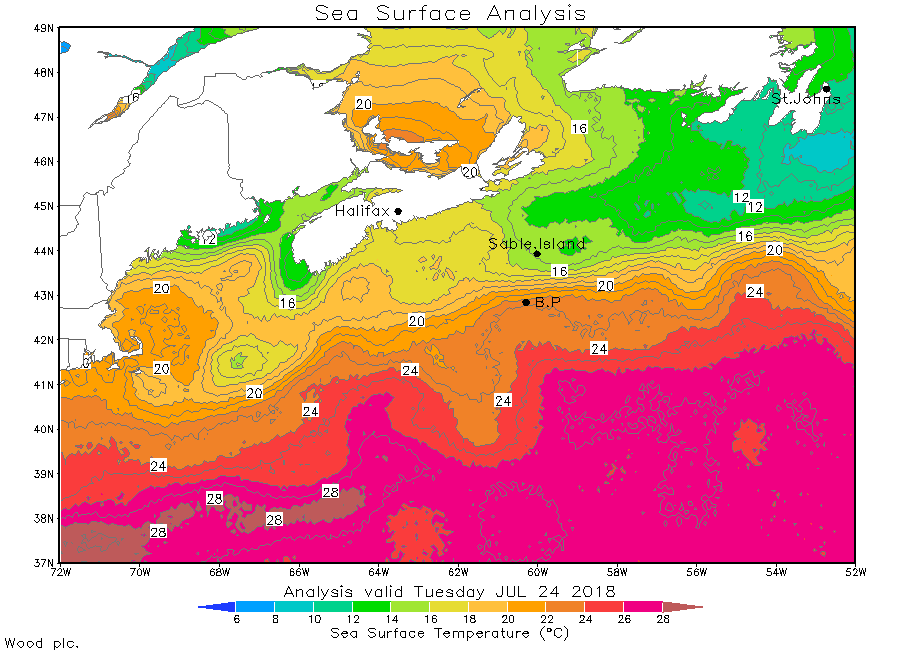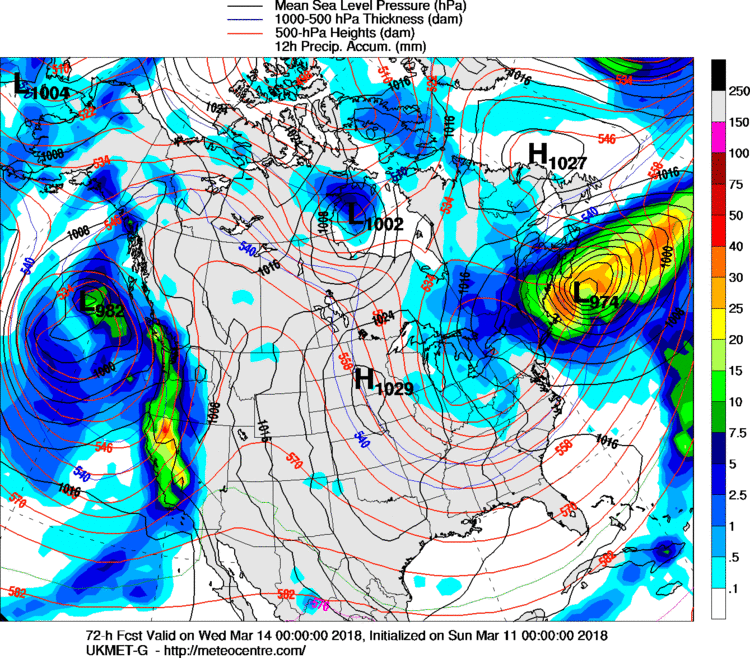
OSUmetstud
-
Posts
16,433 -
Joined
-
Last visited
Content Type
Profiles
Blogs
Forums
American Weather
Media Demo
Store
Gallery
Posts posted by OSUmetstud
-
-
It's now (unexpectedly) a cat 3 if anyone was paying attention lol.
-
 1
1
-
-
1 hour ago, CoastalWx said:
The mean will never do well with the intensity. So toss that with regards to strength. The key is to see what the members are doing. Looked to me that a good amount of members are posing a SE US threat.
There were several trapped under the ridge on yesterday's 12z but it went up a lot on the 00z run last night. Pretty big ensemble shift but that's why you don't make definitive forecasts for a storm 8 to 10 days out. I haven't seen much if any runs with a favorable northeast landfall synoptic look with a Midwest trough. But that could change.
-
Klotzbach was mentioning the possibility of the AMO phase flipping last year. Their AMO calculation is different than CPC.
-
3 hours ago, Typhoon Tip said:
is it normal to have such warm water piled up on the N side of Nova Scotia like that... ? Check out N of Halifax ... that pooling is some 23 C water! Maybe that's normal - I dunno...
Yeah. The Gulf of St Lawrence is really shallow and not part of the westward extension of the Labrador current. It heats up readily in the summer and freezes in the winter. Its been very warm in Atlantic canada
-
17 minutes ago, OceanStWx said:
Not my forte either, but I believe it is tidal mixing upwelling cooler subsurface water.
On the large scale, Georges Bank is part of a very long coastal current system which flows southwestward from Laborador to the Mid-Atlantic Bight (Figure 4; Chapman and Beardsley, 1989). Locally, two oceanic water masses and local air/sea interaction determine the hydrographic conditions within the Gulf of Maine and on Georges Bank (Bigelow, 1926). Cold, low salinity coastal water enters the Gulf of Maine from the Scotian Shelf (Smith, 1983) and warm, saline Slope Water enters through the Northeast Channel (Ramp et al., 1985). Both of these inflows to the Gulf exhibit significant seasonal and inter-annual variability. The two water masses plus local runoff mix during a generally cyclonic (counterclockwise) movement around the Gulf which may slow down or even reverse in part during winter (Brown and Irish, 1992). During the summer, this basin-scale movement may be comprised of smaller-scale cyclonic flows around Jordan, Wilkinson, and Georges Basins (Brooks, 1985, Butman and Beardsley, 1991). In the western Gulf of Maine, near-surface waters flow both southward around Nantucket Shoals into the Mid-Atlantic Bight and eastward onto the northwest flank of Georges Bank (Hopkins and Garfield, 1981; Limeburner and Beardsley, 1982; Beardsley et al., 1991). On the northwest flank, the interaction of strong tidal currents and steep bottom topography results in a strong horizontal density front and a narrow, jet-like current flowing eastward along the northern edge of the Bank (Loder, 1980; Magnell et al., 1980; Butman, 1982). The flow then turns clockwise and slows to move southwestward along the southern flank of the Bank. The strength of this anticyclonic (clockwise) circulation increases with increasing stratification in the spring and summer (Butman et al., 1987). A permanent hydrographic front along the southern edge of the Bank separates the shelf water over the Bank from the more saline Slope Water offshore (Flagg, 1987). Much of the shelf water flowing southwestward along the southern flank of the Bank continues westward into the Mid-Atlantic Bight (Beardsley et al., 1985). During stratified conditions, some of the shelf water on the southern flank of the Bank moves northward through the Great South Channel, forming a partially closed gyre (Butman and Beardsley, 1987).
http://www.usglobec.org/reports/nwaip/nwaip.chapter4.3.html
I think that answers my question. But it still difficult to conceptualize without more imagery.
-
-
On 6/4/2018 at 8:45 PM, BuffaloWeather said:
Anyone know what New Yorks is? Having trouble finding that stat.
BUF's is cold Sunday I believe (Jan 17th 1982). -37F. Also the week before set the record for the lowest wind chill for an NFL game...the AFC Championship game in Cincy "Freezer Bowl" on jan 10th 1982.
-
13/5/1
May 1/0/0
June 1/0/0
July 1/0/0
Aug 5/2/0
Sep 4/2/1
Oct 1/1/0
Nov 0/0/0
-
 1
1
-
-
Just now, 40/70 Benchmark said:
Ok...I'm mobile on plane, so thanks.
yep np.
-
1 minute ago, 40/70 Benchmark said:
Sounds similar to 12z..tick west
nah, this is like 2/3 more qpf than the 12z across the board, more similar to last night's 00z.
-
2 minutes ago, 40/70 Benchmark said:
DT is adamant that Euro, RGEM and UK all trended east at 00z lol
The sfc low is further east on the euro as it passes new england, but the circulation is much larger and there's more phasing with the northern stream trough, so it seems like an academic point as opposed to anything meaningful sensibly.
-
1 minute ago, sbos_wx said:
Anymore details. I'm too lazy to get out of bed
2" cape cod, 1.2" bos, 0.5" CT river.
-
UK looks like 2"+ for the cape and 1.5" for BOS, maybe 1" for HFD?
-
-
Just now, Hazey said:
How's Atlantic Canada looking? Still in play or a whiff? Seems latest guidance is leaning toward the latter.Ensembles are between St. John's and the Grand Banks..moved east over the last 3 days, out of your hood for almost certain.
-
pretty much steady-state on the latest pass. 107 kt peak unflagged sfmr and flight level winds to 121 kts in the ne quad.
-
Those mike ventrice corrected ensemble probabilities for hurricane force winds in nyc look to be working out really well.
-
 4
4
-
-
They found 106 kt sfmr in the ne eyewall on latest pass not sure if theyll increase the winds on the next forecast.
-
2 minutes ago, NJwx85 said:
I was just trying to explain the difference between just a large hole in the center of a hurricane and a more traditional eye with an actual eyewall.
It's going to be a moot point soon anyway as convection is starting to wrap in close to the center again.
Its a closed wall on recon at 38 nm. U really need to stop.
-
 13
13
-
-
8 minutes ago, Ginx snewx said:
It actually made things worse, it wasn't the extreme winds in the tight core that was going to cause Island wide extensive infrastructure damage, it was the spreading out of those winds, the rapid cooling of tops at landfall exacerbated the rainfall, what was a tight core with cane winds confined to a 30 mile radius spread those out 100's of miles. There is nothing good save for the areas that would have gotten wind speeds 25 mph higher
Yeah i think this is true. I feel like things got worse for san juan with the new dominant oew not better.
-
 1
1
-
-
2 minutes ago, NJwx85 said:
I agree that they probably didn't get sustained cat 5 winds there, but they probably gusted over 140MPH. Not sure if we'll ever know since it appears the equipment failed.
Of course they didnt get 5 winds at landfall since it wasnt a 5...
-
 3
3
-
-
2 minutes ago, NJwx85 said:
But they took the wrath of the OEW right as the core was coming onshore. They were also in the RFQ.
They were removed enough from the landfall location that the wind should have weakened by the time the maximum winds reached them.
-
1 minute ago, NJwx85 said:
Downtown San Juan literally sits on the beach. And the newer section, which is further East sits at sea level and on the water.
It didnt make landfall there.
-

.png.e13d5c4e3ae64c31637d364a47fa197b.png)
.png.ea0be6b10a505c94dd4ea9e28c43ac50.png)


.gif.44a4b9802b28c14da235f71f57ca78df.gif)

SNE Tropical Weather Discussion - Hurricanes
in New England
Posted
Yep. Intensity forecast is still a great mystery. Track is pretty good though.